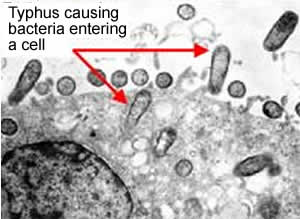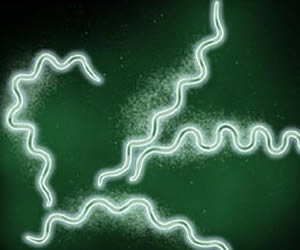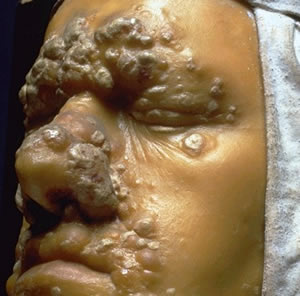Science of Conflict
Diseases
|
| The piercing of
an arrow, the cut of a sword were just as deadly as the slow killers that
lurked in the mud and filth of battle fields. Infection often heralded a
slower but just as painful a death as the tearing of flesh from flying shrapnel.
As late as the 1920s more soldiers died from diseases, poor diet and exposure
to the elements than from wounds. During the American Civil war twice as
many men died from disease than were killed in action. |
| The main killer during the American
Civil War was dysentry, while during WW1 typhus was the greatest killer
been attributed with 3 million Russian lives by the end of the war. |
|
| Few diseases devastated
an army more than syphilis. This bacterial infection, as pictured on the
right, caused havoc amongst civilisations killing millions. Columbus introduced
this disease to Europe which spread quickly in the brothels and taverns.
In 1494, a year after Columbus's return, Henry VIII of France attacked Italy.
Henry experienced instant success with his army made of mercenaries gathered
from a number of European countries. Celebration and exhilaration accompanied
the confident army as they advanced to Naples. All opposition melted away
with the exception of a small group of Italian and Spanish soldiers held
up in a citadel just outside the city. The Spanish were fresh from the taverns
and brothels of Spain infected with syphilis. Henry's army chose to sit
and starve this ragtag army into surrender. |
|
| Through a clever act of deception,
the now desperate besieged army, allowed the prettiest women infected with
syphilis, to live the citadel. French troops, attracted by the women gave
them asylum. The outcome was devastating for Henry's glorious army. The
long, torturous march back home saw many fall dead by the road while others
appeared like lepers as the disease covered their faces and hands with syphilitic
sores, as shown on the right. Many French soldiers became blind or went
insane before been relieved by death. Even more tragic, many found their
way back to their homelands where the telltale signs of the early onset
of syphilis went unnoticed. Relieved to be home the soldiers passed on the
disease before succumbing to it themselves. |
|
Infection was
thought by many to be God's vengeance or the influence of evil spirits.
Since little was known about the way infection is spread many field hospitals
were a breeding ground for bacterial and viral infections. The confusion
of how to treat diseases is captured perfectly by the recollection of
an American doctor Edward Jarvis during his experience as a field doctor
in the 1830's. While bandaging a wounded leg he turned to an assistant
and asked for a plaster. The young assistant replied," I do not know
if we have exactly the one you need in the drawer". To Jarvis's horror
the cupboard revealed a collection of used plasters and bandages that
had been removed from ulcers, cuts and other wounds and covered in blood
and pus ready to be reused.
Many more soldiers died needlessly
on hopsital beds before the link between infection and hygiene was to
be made during the second half of the nineteenth century. |
What are the symptoms of
typhus?
How does syphilis bacteria
enter the body?
What are the symptoms
of syphilis?
Can syphilis be teated by modern day drugs?
How does good hygiene prevent
deadly infections?
How did hospitals contribute
to the high mortality rate?
|
|
|


